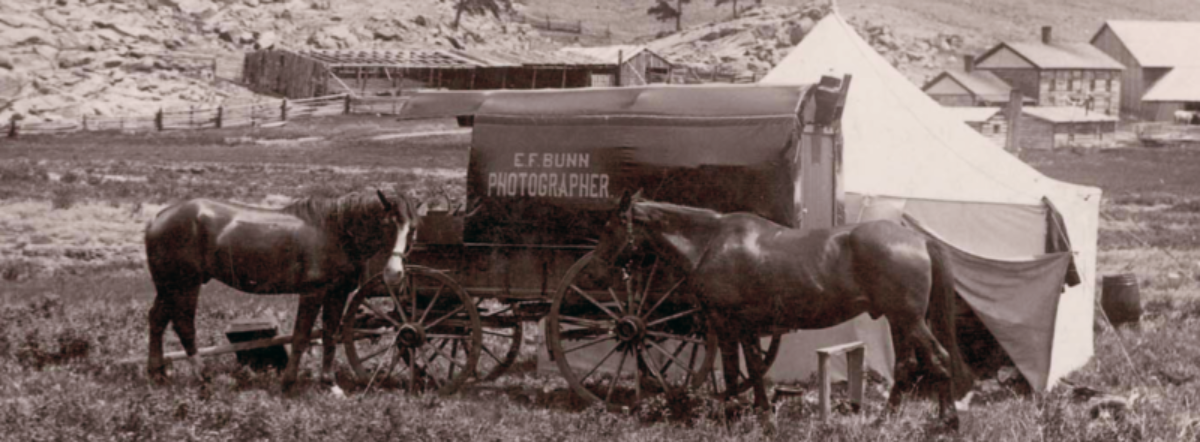I visited Sterling, the largest city on Colorado’s Eastern Plains, and went to the Overland Trail Museum. During my visit, I discovered a couple of new photographers from early Colorado to add to my list of camera artists. Please let me know if I have missed any.
Gustaf Robert Appelblad was born on March 27, 1863, in Jönköping, Sweden. He learned photography from his brother Ture Appleblad. In 1882 Gustaf immigrated to the United States and shortened his name to Appel. He settled in Minneapolis, Minnesota. Three years later, Appel established himself in Central City, Colorado, working as a retoucher. In May 1886, he purchased B. A. Lindquist’s studio. He claimed to make about 200 portraits a month and to produce roughly 2,000 prints.

On June 4, 1887, Appel married Anna C. Johnson in Central City. The couple moved to Sterling in August 1889. The following year, he set up a tent gallery in Idaho Springs. In June 1891, Appel purchased a large photography studio at 1527 Larimer St., Denver, Colorado. During his seventeen years in Denver, he advertised extensively in the Swedish newspaper Svensk-Amerikanska Western. He also participated in local politics, running for office as a socialist.
In May 1908, Appel sold his studio to Leroy Kellog and took up residence in Eaton, Colorado. Gustaf R. Appel died on November 22, 1911, at the age of 48. His remains rest in Denver’s Fairmount Cemetery.
Boston Railroad Photo Car
Active in Sterling in March 1889. Operated by J. S. Legerton. (See below)

Denver Travelling Photograph Gallery
Based on a small group of cabinet cards held by the Overland Trail Museum, it appears that the Denver Travelling Photograph Gallery may have visited Sterling. The photographs all show signs of fading, likely due to poor chemical processing, possibly as a result of a quick turnaround time. I have been unable to find any additional information about this studio.

Isaac Newton Ford was born in Illinois on October 26, 1850, to Aquilla Ford and Nancy Galbreath Ford. He spent his childhood on a farm in Linn County, Kansas. The 1880 federal census lists Ford as a miner in Fairplay, Colorado. He settled in Iliff, Colorado, marrying Harriet Louise Miers Monroe on December 2, 1884.
In the 1890s, Ford had learned photography. On May 31, 1910, Ford was thrown from his horse-drawn wagon and died from his injuries, leaving behind a wife and four sons. Ford is buried in Sterling’s Riverside Cemetery.
L. F.
Active in Sterling in March 1889. I was not able to identify this photographer.

John S. Legerton was born in England in 1862. At the age of twenty, he arrived in the United States. Legerton worked as a traveling photographer visiting towns in Nebraska, Kansas, Colorado, California, and Montana, often for only a few days at a time. His businesses and partnerships changed throughout the years, including Chidester & Legerton, Legerton View and Photograph Co., Legerton & Moorehead, Legerton & Gregory Photo Co., and Boston Railway Photo Car.
Between 1886 and 1890 Legerton’s home base was Iliff, Colorado. He spent the latter decades of his life in the Los Angeles, California area as a dealer in second-hand bottles. John S. Legerton died on August 29, 1955 in Los Angeles.
E. F. Phillips was a photographer and sign painter in Sterling, CO, between 1890-1896.

Orion U. Roberts was born in August 1869 in Rush County, Indiana to James Harrison Roberts and Augusta Green Roberts. Orion’s mother passed away when he was four years old, and ten months later, his father married his sister-in-law, Winifred Marillas Green. Orion attended school in Indianapolis.
On July 2, 1892, Orion married Mary Foster in Cook County, Illinois. By 1897, they were living in Colorado, where Orion practiced photography. He set up a temporary studio in Castle Rock, before moving to Sterling, Colorado, where he stayed for several months. In 1900, he had a studio at 710 Santa Fe in Denver. The 1910 census places the couple in Seattle, Washington, with Orion working as a carpenter. Orion Roberts died on April 3, 1933, in Washington, Oregon. He was survived by his wife.


John C. Sanders was a traveling landscape and portrait photographer in Iliff, Colorado, c. 1887. He also represented the firm of Legerton & Gregory Photo Co., taking orders for photographs.
Frank Stewart was born on December 1, 1859 in Cambridge, Ohio to John Stewart and Elizabeth Stiles Stewart. He married Hepzibah Rae Reynolds on February 12, 1890, in Dallas, Iowa. He may have been active as a photographer in Scranton City, Iowa in the mid-1890s. By 1899 the Stewarts had relocated to Sterling, CO, where they built a six-room residence. Frank ran a photo gallery there, producing local views and portraits. Notably, six of his baby portraits were featured in the Denver Times baby contest. In May 1900, he established a branch gallery in Brush, Colorado managed by H. M. Vredenburg. A few years later, the Stewarts moved just south of Sterling to Atwood, where they operated a dairy farm. Frank Stewart died on January 3, 1937. He is buried in Las Animas Cemetery, Las Animas, CO.
Thank you to Brian Jesteadt, Museum Assistant, at Overland Trail Museum, for his expertise and assistance during my visit. Karen Hendrix kindly supplied a scan to illustrate I. N. Ford’s work.

















